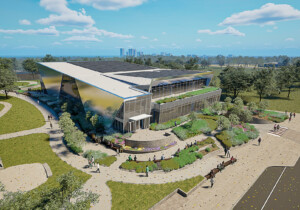How a boutique Brooklyn design-build collective strung up NeoCon’s first major installation.
Attendees of NeoCon in Chicago’s Merchandise Mart rode the escalators and ascended towards Wolf-Gordon‘s large crystalline canopy hanging overhead. Though NeoCon has come and gone, Wolf-Gordon has just begun using the tessellated, prismatic structure for an ad campaign that, for the company’s new Chief Creative Officer, Marybeth Shaw, signifies a renewed approach to design and a willingness to take risks. To announce Wolf-Gordon’s new face to the world, Shaw enlisted the help of advertising agency Karlssonwilker, who has created campaigns for Adobe, the New York Times Magazine, BMW, Vitra and MTV, among others, and The Guild, a Brooklyn-based design and build collective whose clients include Dior, Louis Vuitton, Nike, Hurley and Diane von Furstenberg. It’s a bit of an unexpected mix of talents, to be sure, but Shaw wanted to shake things up.
After developing a concept with Karlssonwilker that was inspired by Bruno Taut’s 1914 Glass Pavilion, Shaw turned to The Guild, where Creative Manager Graham Kelman translated her idea into a spiky, crystalline form onto which Wolf-Gordon’s fabrics, textiles and wall coverings could be displayed. Kelman’s first design had between 650-700 prismatic faces with an area far too small to show off the fabric, so Kelman decreased the amount of faces to around 250 while also increasing their individual size. “I increased the largest spike from three to six feet by using a sheet of material per spike side,” Kelman said. He was able to decrease “the total number of faces by two-thirds and still retain the aesthetic impact, volume and material” he wanted.
To decide on how to position a combined total of 500 yards of fabric as well as the pieces of mirror used throughout the installation, Kelman “assigned the most dynamic components and mirror panels to the most prominent views within the space.” He and Shaw collaborated on the placement of the fabric swatches and then passed their design onto The Guild’s Lead Fabricator, Jorge Parriera, who made a prototype he then used to refine CNC cut-files and tool path depths, finessing it “to maximize the bending of the aluminum panels and shear strength that would accumulate as the piece became assembled,” Parriera said. “With every component that was added to the structure, new stress points would arise and others would subside. The structure only gained full strength when it was completed.”
One of the original goals was for the structure to be self-supporting, so The Guild developed a technique of CNC routing and folding aluminum panels like origami to form rigid components. Once fabrication was completed, the entire installation was rigged from a truss in the shop to test its weight, balance and stress points. It was then broken down into eight separate pieces for transportation to Chicago.
“We attempted to develop an ‘open crate’ system, we spoke about the crutches in Salvador Dali’s paintings and about suspending the structure in the truck,” said Parriera. “Ultimately, we obsessively protected each point on each spike and turned each segment until it sat naturally. Then we extensively padded the floor of the truck and ratcheted the structures to the wall. When we got onsite there was no damage.”
Everything went according to plan during the two-day installation process. Parriera and his small crew simply repeated the trial run they made in their shop back in Brooklyn. All in all, Marybeth Shaw estimated that the canopy cost under $100,000. That’s money well spent from her perspective. Not only is she, The Guild and everyone at Wolf-Gordon exceptionally pleased with the outcome, the 40,000-person crowd at NeoCon got the message that Wolf-Gordon is up to something new these days.










